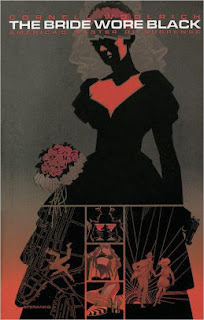 |
| Cover of my copy |
Wikipedia lists 48 Woolrich stories which were turned into films, four of which are from the black series (original title/film title): Black Alibi/The Leopard Man (1943), Black Angel (1946), The Chase/The Black Path (1946), The Bride Wore Black (1958). One of his stories that made it into film should be instantly recognized: in 1954 Hitchcock filmed Rear Window starring Jimmy Stewart and Grace Kelly which was adapted from the Woolrich story, "It Had
 |
| Cover on Amazon |
to be Murder".
By itself, The Bride Wore Black would be a pretty good novel to start a career as a writer of pulp and detective stories but to have the first book a noir is even better. Eddie Duggan (link below) sees psychological instability as an attribute of characters in noir and combine that with Otto Penzler's dictum that there are no happy endings for the noir protagonist then The Bride Wore Black fits into the genre nicely.
This is a female revenge story. For most of the book, we don't who the woman is or why she is bent on revenge against men between whom there is no evident connection. The title gives a clue but no idea how it relates to her victims.
Woolrich hit upon a structure for the novel that I think is as bold as choosing to start with noir. The book has five section and each section has three chapters all with the same titles: The Woman; chapter named for the victim; and Post Mortem. The first is the setup, the second is the assassination, and the third is Detective Wanger's report. The Woman is shown to be beautiful, ruthless, a master at disguise, and a meticulous planner — a genuine femme fatale. Wanger is the only one to see a connection between the seemingly unrelated murders. The events in the book are spread over several years and Wanger is obsessed with finding connections ... and The Woman. In the end it is a chance remark that makes the pieces come together.
The revelation comes at the end when the reader finally gets the whole story and what a story it is. I'll only say it is the icing on the noir cake. It is a very satisfying read and I recommend it. Now I need to get my hands on the film made from the book, The Bride Wore Black directed by Francois Truffaut in 1968. I have to see if it keeps the noir flavor but considering it's Truffaut I imagine it will.
I enjoy Woolrich's style of writing and given when it was written it holds up very well and I would't consider dated for modern readers. I did learn that women wore wimples back then which I had only associated with nuns. He has a nice flowing style that is a pleasure to read. He is excellent with descriptions and developing characters. My favorite might be Part Two, Mitchell, The Woman, where he describes Miriam, a maid at the Helena Hotel, and her routines. I took a lot of pleasure in the way Woolrich put the words together.Duggan, Eddie, "Writing in the Darkness: The World of Cornell Woolrich".
I liked all the covers and couldn't decide which to use so I used them all

No comments:
Post a Comment